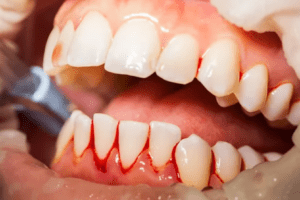Gum disease is a condition that affects the soft tissues of your gums. When you brush and floss your teeth each day, the goal is to remove as much plaque as possible. This is because plaque is the main contributor to tooth decay and gum disease. Plaque is a sticky, white bacteria that clings to all surfaces in your mouth. If you don’t remove plaque properly, it can cause long-term dental problems.
In its early stages, your dentist can offer many treatment options. In fact, you are likely to eliminate gum disease altogether. Early-stage gum disease, also called gingivitis, can be completely reversed with the proper treatment. Unfortunately, late-stage gum disease is a long-term problem. You will need consistent treatment to avoid the damaging effects.

Effects of Gum Disease
The earliest signs of gum disease can be hard to miss if you don’t pay close attention to your oral health. Gum disease can cause your gums to become red or swollen. Additionally, you may see mild bleeding when brushing or flossing. While brushing too hard can cause bleeding, you should still consult your dentist.
The longer you wait to seek treatment, the more likely you may experience more serious side effects. For example, gum disease can cause gum recession. As plaque builds near and underneath your gums, they become irritated and begin to pull away from your teeth. Gum recession can range from mild to severe. In fact, your gums can recede enough to expose the roots of your teeth.
As your gums recede, your teeth can become loose. This is because your gums help keep your teeth in place. Without the structure of your gums, your teeth no longer have stability. Eventually, you can even lose some of your teeth.
Treatment Options
Initially, your dentist will likely prescribe antibiotics to help fight the infection. It is important that you take all of the medication as your dentist recommends.
They may also perform a deep cleaning on your teeth called dental scaling and root planing. You can think of this as a more intense dental cleaning where they remove plaque and tartar from your teeth and underneath your gums.
Gum contouring or gum surgery are other options for advanced periodontal disease. When plaque builds underneath your gums, it can create pockets of plaque, which need removal. As a result, your dentist will need to create an incision with a scalpel or laser to create flaps.
This is called a pocket reduction surgery or a gum flap surgery. It allows them to get underneath your gums and completely remove the plaque. Then, they will thoroughly clean and disinfect the area before they replace the flaps. At any point during this surgery, they may need to contour or reshape your gums.
Actually, your dentist can use gum contouring as a cosmetic procedure. If you have a gummy smile or damage from gum disease, they can use lasers to reshape your smile easily.
